Bunker Hill Covered Bridge – Built 1895
With only two historic covered bridges existing in North Carolina (NC), I decided I couldn’t feature the Pisgah Covered Bridge last week without the other, the Bunker Hill Covered Bridge this week. This required another Sunday drive.
The Bunker Hill Covered Bridge is not only historic, built in 1895, but it’s designated as a National Civil Engineering Landmark being the last wooden bridge in the United States with Haupt Truss construction. Also on the National Civil Engineering Landmarks list you’ll find in North Carolina the Cape Hatteras Lighthouse, the Blue Ridge Parkway and the Dorton Arena — so this bridge is in good company.
Haupt Truss Construction, an improved lattice truss, was patented by Gen. Hermin Haupt (1817-1905) in 1839. Haupt was Chief of Military Railroads for the Union Army during the Civil War and was one of the first to develop a rational method of truss analysis in America.
This Bunker Hill bridge, in my opinion, is more impressive then the Pisgah bridge — the span is much wider at a greater height. Massive oak timbers and wooden pins makes the bridge feel very safe and secure even today. Originally the bridge had a wooden shingle roof but during a major restoration in 1994 a tin roof was applied for longevity.
Now you might ask, “Why build covered bridges?” A few good reasons:
- Covered Wooden bridges prevented heavy snows/ice from covering and/or blocking passage
- Barn-like appearance soothed animal fears of bridge crossing (prevented horses from bolting.)
- Covered bridges protected travelers from the sun and weather.
- Covered bridges protected the exposed wooden superstructures from the elements. An uncovered wooden bridge may last 15-20 years: but with a roof and sides, one would last as long as 100 years.
Here ends my Covered Bridge history lesson…North Carolina has no more historic covered bridges, and you’re probably thankful for that! ;-)

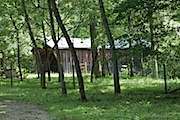
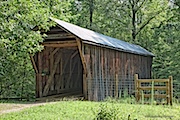
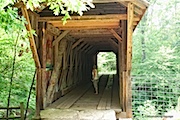
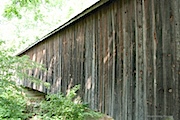
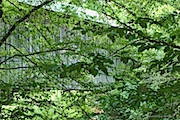
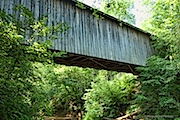
Well I enjoyed your post, it reminded me of this construction http://www.prosiectmenai.co.uk/bbhistory.php which I remember looking at many years ago but that tragically didn’t survive as well as your example has done.
Colin, thanks. Some enjoy a little historical fact along with a photo while others might find it boring — I’m glad you enjoy this. Thanks for the link.
This bridge has a fascinating history. Thanks for the links, too. The gallery shows the lattice construction nicely as does your shot of the interior. It’s been educational (and fun) going through these posts. Too bad there are no more covered bridges, but your state is rich in history so you have enough to keep yourself busy.
Thanks, Ken. As a young child my mother and aunt brought my sister, my cousin and I to this stream and covered bridge to have picnics and play in the water during the summers when school was out. Now that would of been close to 50 years ago and at the time it made quite an impression upon me.
Of course your right, I’m sure I’ll find something else to focus on. :-)
After reading first of the deaths of dogs on the Overtoun Bridge in Scotland (Google this–it’s quite a terrible story), and then seeing this covered bridge here, it makes me wonder why the other bridge has never been covered.
Hi Susan, I’ll “Google” that story today! Once engineers moved on to longer lasting materials for bridges, steel and concrete, the need and cost of covering them doomed the cover bridge.
Susan, I just read the story you mentioned…how strange it is — it will play on my mind for some time. There’s so much we don’t understand, isn’t there. Thanks for mentioning this.
These posts that provide education are some of my favorites. It had never crossed my mind that the cover helped to keep the team from bolting. Brilliant! Your beautiful pictures are a delight. They give me a clear sense of almost “knowing” this lovely old bridge. And, what precious memories were made with those childhood outings.
Anita, what a nice thing to say. if by words and photos I can introduce someone to a place or thing I know or have seen, giving a sense of “almost familiarity” — that’s a wonderful thing in my book. :-)
Thanks!
Now that was a great history lesson. Those are some great reasons for covered bridges. I wonder why there weren’t more of them, especially given the longevity of the bridge. Fascinating reading, Earl. Thanks for the info. And you’re right, the bridge is in good company!
Paul, Thanks! At one time there were hundreds or perhaps thousands in the state. I don’t know why more were not preserved…perhaps many of them were demolished when replaced with steel structures and by the time they became “historic” perhaps for most it was too late.
Thanks for the explanations of why, I was ready to ask when I saw you’ve lined up a good list. I can appreciate the rationales, the construction will inevitable get a longer life this way. I guess there were no need for them when steel took over.
Ove, thanks. “Why are they covered” is a common question so I thought I share the answers I’ve found thus far.
A fine, old bridge that is a classic. Thanks for the informative comment on its construction.
Very nice post.
Don, thanks. I wasn’t aware of the construction details until I visited the bridge.